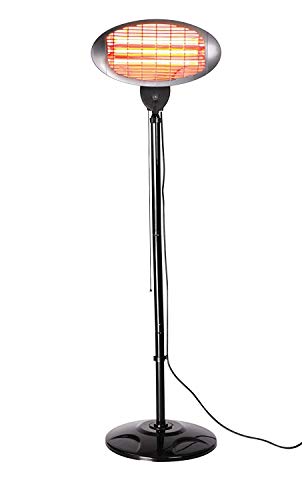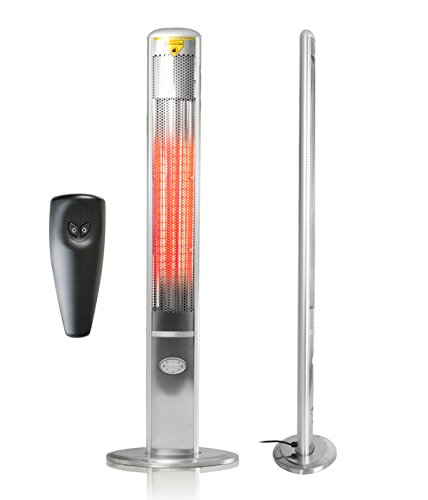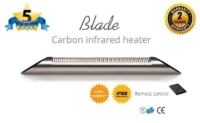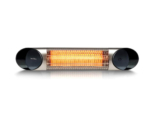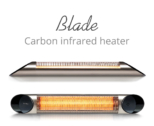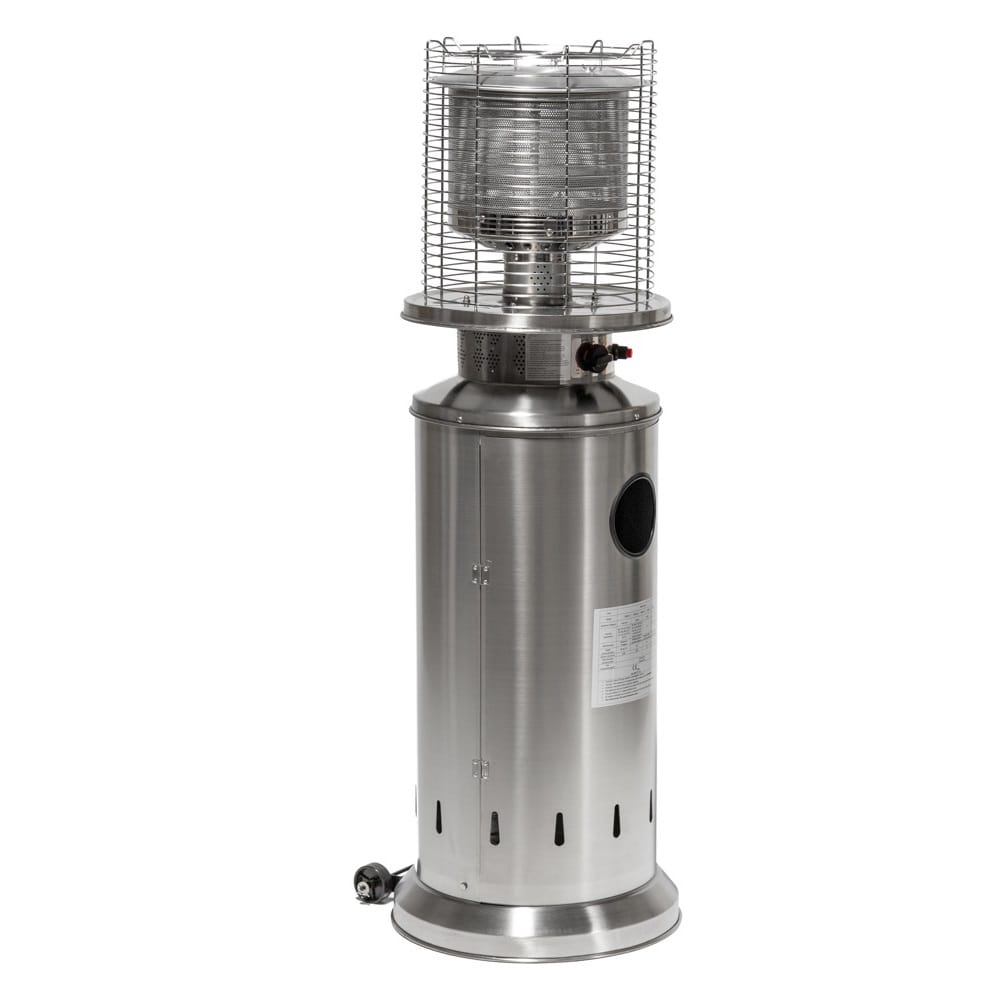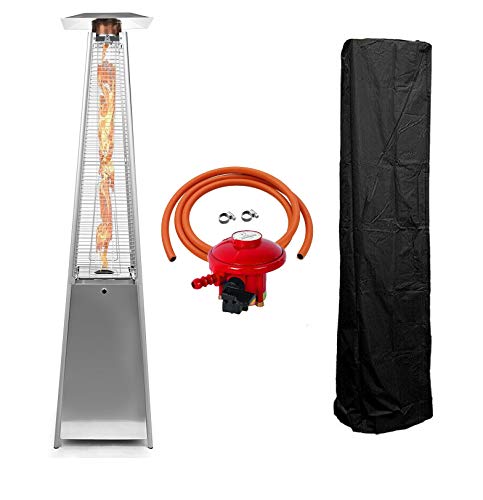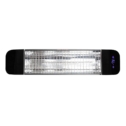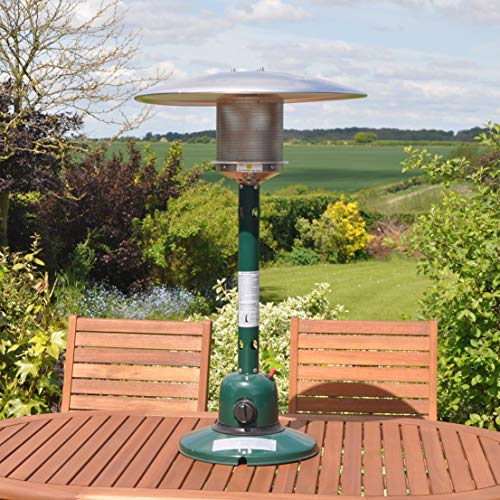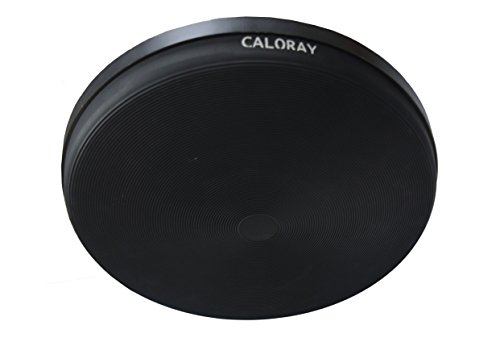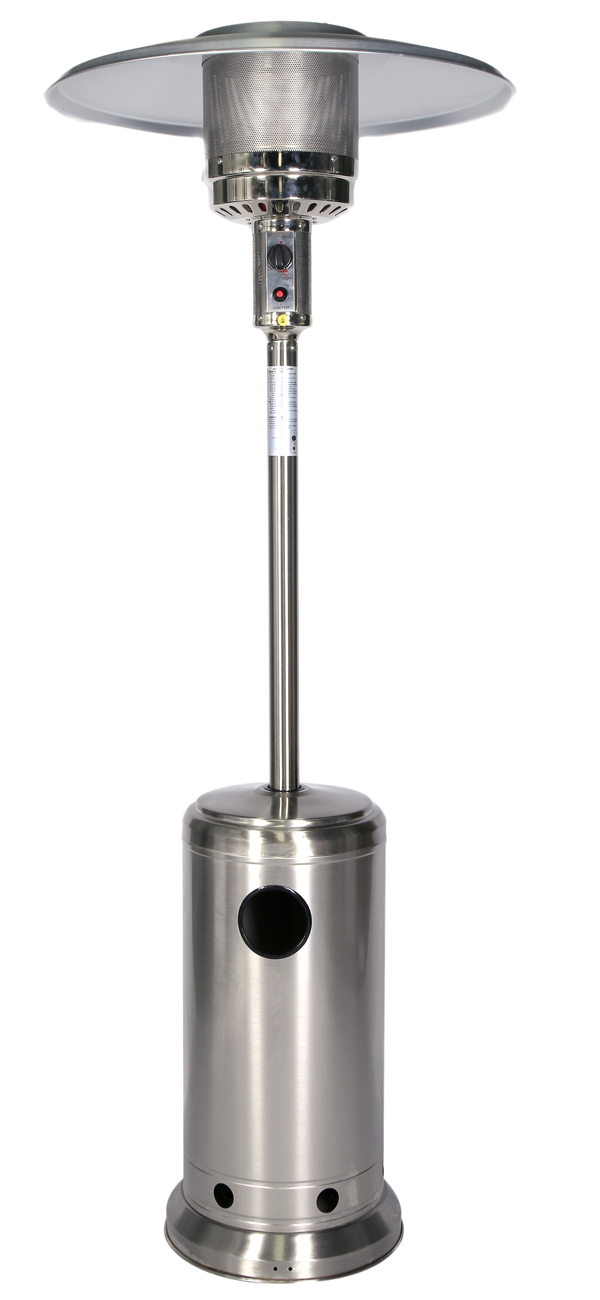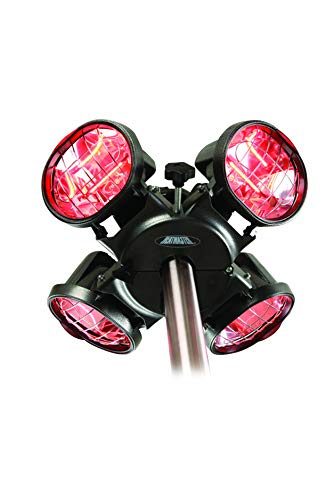Welcome to our post on our best patio heaters of 2024. We’ll be taking you through our favourite patio heaters of the year and covering topics like; running costs, fuel type, heating type & heat coverage. We’ll also go through the pros and cons of each of these garden heaters in detail!
We feel the need to mention that “best” is a subjective term, so rather than just produce a list of 10 random heaters, we have created a list of different heaters that excel in their particular field. We’ve based our list on cost effectiveness, style, consumption, popularity, as well as taking features and price into account.
Please do let us know what you think in the comments at the end and if you end up purchasing a heater, come back and leave a review for others to read!
This Guide Was Last Updated On: 26th February 2024

In This Guide
- Patio Heater Buyers Guide
- Introduction to the Different Types of Patio Heaters
- Different Fuel Types
- Efficiency, Energy Consumption & Heating Type
- Features of Each Heater & Suitability
- Different Types of Infrared & Glare, Low-Glare or No-Glare?
- Best Gas & Electric Patio Heaters for 2024
- Firefly (HeatLab) 2kW Electric Weatherproof Infrared Garden Heater
- Firefly 1.8kW Weatherproof Electric Slimline Garden Patio Heater
- Veito Blade Series Electric Weatherproof Infrared Heaters
- Firefly (HeatLab) 12kW Gas Floor Standing Stainless Steel Outdoor Bullet Heater
- Dealourus 13000W Pyramid Gas Patio Heater
- Devola Wi-Fi Enabled Smart Patio Heaters
- Kingfisher 4kW PH300 Gas Table Top Outdoor Heater
- Caloray 2kW Electric Weatherproof Convective & Radiant Wall / Ceiling Mounted Heater
- 12kW Firefly (Heatlab) Gas Stainless Steel Outdoor Floor Standing Patio Heater
- La Hacienda Heatmaster 2kW Parasol Heater
- Best Selling Patio Heaters
Introduction to the Different Types of Patio Heaters
Before we get started, let’s cover some of the basics of the different types of patio heaters available on the market.
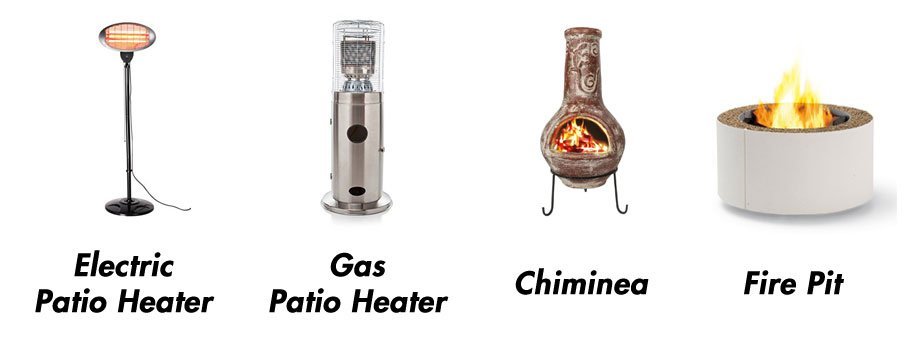
Whether you’re looking to provide heat in the garden, on the patio or deck, or even if you’re a commercial users that require heating in the pub, restaurant, club or smoking area, fear not. There are a huge number of practical solutions to outdoor and indoor heating depending on your requirements.
First you need to decide what style of patio heater you want, as they come in an array of different types, which include (but are not limited to) floor standing / free standing, ceiling mounted, parasol, table top or wall mounted.
So try to pick the best patio heater for your needs. Commercial users might opt for gas or carbon fibre electric patio heaters as these offer the best bang for your buck. While residential users would probably go for quartz or halogen electric heaters and the cheaper alternatives.
Once you’ve figured out the style of heater you’re after, you need to decide on which type of fuel you’re going to be using.
Top 3 Best Selling Patio Heaters
| # | Preview | Product | Rating | Price | |
|---|---|---|---|---|---|
| 1 |

|
REALGLOW Real Flame Outdoor Pyramid Patio Heater in Stainless Steel - 13KW Propane Gas Standing... | No ratings yet | £189.99 | Buy on Amazon |
| 2 |
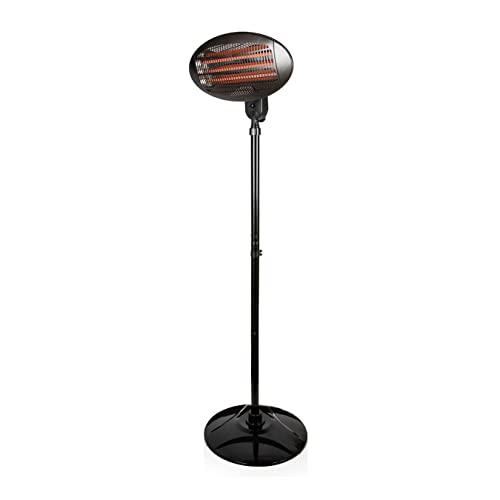
|
Warmlite WL42009 Quartz Portable Patio Heater with 3 Heat Settings, 5000 Hour Lamp Life, 2000W,... | No ratings yet | £39.99 | Buy on Amazon |
| 3 |

|
REALGLOW Heatmaster 15KW Flame Patio Heater in black with Glass Tube | No ratings yet | £219.99 | Buy on Amazon |
Different Fuel Types
Most standard patio heaters will consume either gas or electricity. There are other types of heaters on the market that consume bio-fuel, wood (or alternative solid-fuels) and ethanol heaters, but they aren’t “traditional” patio heaters and tend to fall under either chimineas or fire tables.
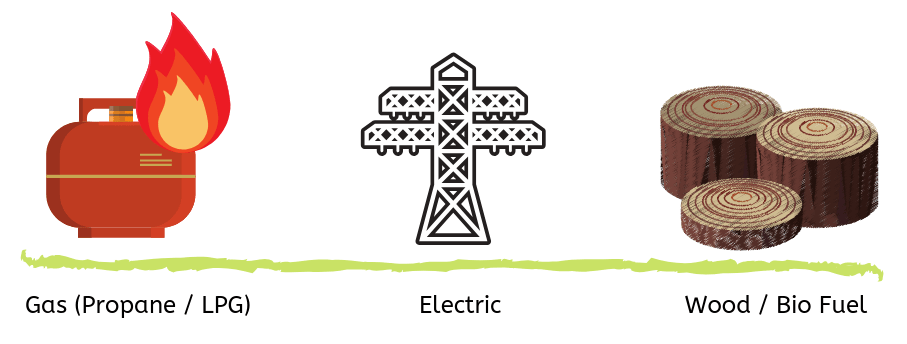
The vast majority of patio heaters will consume either electricity or gas as their energy source.
If you’re looking for something different, there are a few unique products on the market, we’re fans of the fire table style heaters – although be warned, they come at a cost.
Efficiency, Energy Consumption & Heating Type
Consumption is measured in Watts – e.g 2000W or 2kW but consumption doesn’t indicate efficiency or heat output, so buying a higher wattage heater won’t necessarily result in more heat!
We’re looking for BTUs (British Thermal Units) for gas and heat coverage as our primary indicator of efficiency.
For example a 3kW Gas Powered Patio Heater vs a 3kW Electric Powered Patio Heater will yield vastly different results as shown below.
| Heater Type | Consumption (W) | Heat Coverage | Hourly Running Cost |
|---|---|---|---|
| Electric | 3000W | 30sqm | Approx £0.45 |
| Gas | 3000W | 5-7sqm | Approx £0.62 |
We’ve given you a rundown of the average life expectancy and cost of the different types of electric heaters below. As a general rule of thumb, the more you pay for the heater, the longer the elements will last and more bells and whistles it’ll come with. Replacement elements will be more expensive but will also need replacing less often.
Commercial users or those of you that need to heat a larger area will do better with patio heaters that use carbon elements, whereas home users may be better off with halogen or quartz heaters.
It doesn’t end there, as these heaters also offer different types of heat. Gas heaters will provide convective heat, which means it heats the air around it as well as objects in the nearby vicinity. In contrast, most electric heaters will give off radiant heat, usually via infrared bulbs or elements, be it quartz, halogen, carbon, ceramic or otherwise!
An advanced 3000W carbon electric infrared heater will be able to provide heat coverage for up to 30sqm, whereas a 3000W table top gas patio heater will provide around 5-7sqm of coverage.
The cost of running a patio heater isn’t just limited to what you’ve paid for it and the cost of fuel, be it gas or electric. You’ve also got to factor in how long the heater and parts will last.
For example, a cheap gas patio heater with powder coating and no waterproof cover will rust after 1 season, so we recommend that you purchase a gas stainless steel patio heater whenever possible, as these last substantially longer for just a few quid more.
If you’re choosing an electric patio heater (which we recommend over gas heaters, but you won’t always have access to an outlet so we won’t preach!) – you’ll find that the patio heating unit itself will last “forever” but you have to be mindful that the elements or lamps within these heaters need replacing after a certain number of hours.
Traditionally halogen and quartz bulbs or elements last between 3,000 to 5,000 hours, while carbon or ceramic elements tend to last 7,000 to 10,000+ hours and these are by far the best patio heater bulbs in terms of heat coverage and longevity.
However carbon heaters aren’t as efficient when used in wide open spaces as their quartz counterparts.
| Element / Bulb Type | Lifespan (Hours) | Heater Cost | Replacement Element | Heating Area (sqm) | Consumption (Watts) |
|---|---|---|---|---|---|
| Halogen | 3,000 to 5,000 | £30-80 | £8-25 | 3 to 12 | 900 to 3,000 |
| Quartz | 3,000 to 5,000 | £30-200 | £8-60 | 5 to 15 | 1,200 to 3,000 |
| Ceramic | 5,000 to 10,000 | £100-400+ | £30-60 | 10 to 30 | 1,200 to 4,000 |
| Carbon Fibre | 7,000 to 10,000+ | £70-400+ | £35-120 | 15 to 35 | 2,000 to 4,000 |
Electric heaters are by and large the most efficient of the two, as they convert over 94% of the energy consumed into heat and produce up to 90% less Co2 emissions than their gas counterparts. They also cost substantially less over the course of time than gas heaters.
Curious how much a patio heater costs to run? Or how long a bottle of gas will last in a patio heater?
Features of Each Heater & Suitability
Another thing to look out for, is the added features of each heater. Whether it’s a free protective cover, a remote control, glare reduction or suitability for indoor or outdoor usage.
All of the heaters listed today are suitable for garden or outdoor use and all the electric heaters listed can be used indoors as well!
When looking at protection from the elements, you’ll be looking for an ingress protection (weatherproof / waterproof) rating of at least IPX4, which would indicate protection against splashing water.
Most electric heaters come with a rating of IPX4 or above, but some go as high as IP67 – offering complete protection against dust ingress and submersion in water up to a depth of 1 metre!
Most users won’t need a fully weatherproof heater but try to aim for IPX4 and above. You can read more on IP ratings here.
Different Types of Infrared & Glare, Low-Glare or No-Glare?
Electric patio heaters offer one of three different types of infrared heat:
A) Short-wave or “near” infrared, with operating temperatures up to 2,700C.
B) Infrared or “middlewave / medium” infrared heat operating at temperatures between 500 to 800C.
C) Far-infrared or “longwave” infrared with temperatures of less than 500C.

These infrared heaters are different to the traditional fan heaters that you may have come across, or had to use when your boiler is on the fritz, which provide convectional heat by heating up a coil and blowing air over it to heat a room.
There’s no right or wrong answer when choosing the best patio heater in terms of glare. Both short and medium infrared heaters are near instant heat, while no-glare heaters can take a bit longer to warm up due to the ceramic or carbon lamps.
In terms of glare, it’s quite simple – ceramic heaters provide no glare as there are no light emitting elements, carbon fibre heaters tend to be glare or no-glare with light reduction elements, usually gold covered, which increases heat coverage by up to 20%.
Halogen and Quartz offer glare or low glare options. Low glare elements are more expensive due to the increased manufacturing cost but may come with an extra 2,000 hours of lifespan.
| Heater Type | Infrared Type | Glare Type | Type of “Heat” | Operating Temperature |
|---|---|---|---|---|
| Halogen | Near Infrared | Glare or Low Glare | Hot / Intense | Up to 2,700C |
| Quartz | Near & Medium Infrared | Glare or Low Glare | Medium | 500 to 800C |
| Ceramic | Far Infrared | No Glare | Comfortable | Less than 500C |
| Carbon Fibre | Far Infrared | Glare or Low Glare | Comfortable | Less than 500C |
Carbon and ceramic heaters offer a much “cooler” far-infrared heat, making them more practical in commercial spaces. They may cost more but they’re worth every penny.
Firefly (HeatLab) 2kW Electric Weatherproof Infrared Garden Heater
Our Best Electric Patio Heater Overall
Fuel Type : Electric | Heat Type : Infrared | Power : 2kW
Features : 3 Power Settings & IPx4 Weatherproof Rating
Suitable for : Home Users & Commercial Users
Usage : Indoors & Outdoors – Free Standing, Wall Mounted & Baseless
Read More
This was one of the first patio heaters reviewed on this website and with good reason! It has been the #1 best selling garden heater on Amazon and has been one of the most reasonably priced heaters on the market for years.
Although prices have skyrocketed due to low stock, Primrose have tried their best to keep stock coming in and this has resulted in a premium on these heaters.
Prices have come down somewhat from their peak of £250 per heater – you should expect to see this priced around the £100 mark now.
It comes in 3 different “formats” depending on your heating requirements and whether you want it floor standing, wall mounted or baseless. It also comes with a basic level of water protection. The quartz infrared bulbs are rated for up to 5,000 hours of life and the Firefly 2kW comes with a 2-year warranty.
This is a perfect starter heater for the home user that works both indoors & outdoors! Although the heating area is mediocre, expect some heat but not all that much coverage.
You can also get a a No products found. if you order two heaters at the same time.
- Cheap to Run
- Weatherproof (IPX4)
- Easy to Assemble & Adjustable Height
- Multiple Power Settings
- Long Element Life
- Leaves Something to be Desired Aesthetically
- Potential High Price Due To Stock Shortages
Alternatives
VonHaus 2kW Heater – Similar price & Settings
Firefly 1.8kW Weatherproof Electric Slimline Garden Patio Heater
Stylish & Jam Packed With Features
Fuel Type : Electric | Heat Type : Infrared | Power : 1.8kW
Features : Weatherproof rating IP55, 2 Power Settings, Built-in PIR Sensor, Remote Control
Suitable for : Home & Commercial Users
Usage : Suitable Indoors & Outdoors
Read More
This is a sleek and stylish weatherproof heater that boasts a number of additional features including a built in PIR sensor which will turn the heater off after no movement has been detected for 5 minutes, helping save you money and the environment. Fear not though, this feature can be turned off so you won’t have to flail your arms around every few minutes 😉
It is suitable for usage both indoors and outdoor and offers up to 7sqm of heat coverage. So it won’t heat the whole garden but will keep users within a ~2.5m range nice and warm with the carbon halogen elements.
For peace of mind, you’ll receive a 2-year warranty from Primrose.
It has a solid build which offers protection from rust should you wish to leave it outside and why wouldn’t you seeing as it has a superior IP55 ingress protection rating. It also comes with a weighted base and anti-tip protection.
- Superior Weatherproof Protection (IP55)
- Anti-Tip Protection & Weighted Base
- Stylish Silver Aluminium Rustproof Design
- Remote Control & PIR Sensor
- Fairly Expensive
- Carbon Element Heaters Require either Close Placement or Protection From Wind To Be Effective
Veito Blade Series Electric Weatherproof Infrared Heaters
Veito Blade S2500 2.5kW Electrical Waterproof Wall Mounted Patio Heater
Veito Blade Mini 1.2kW Weatherproof Carbon Heater
Veito Blade 2000 2kW Electrical Waterproof Patio Heater
Long-life elements – Great for commercial and home users! – Best Patio Heater Overall
Fuel Type : Electric | Heat Type : Carbon, Infrared | Power : 1.2kW / 2kW / 2.5kW
Features : Weatherproof rating IP55, Remote Control, Mounting Brackets
Suitable for : Home & Commercial Users
Usage : Indoors & Outdoors – Wall Mounting or Free Standing
The Veito blade series is where we start to get serious about our heaters. These are truly some of the finest crafted patio heaters available on the market. They’re so good, that they’re the heater of choice in the White Desert Camp in Antarctica!
Instead of the traditional halogen or quartz element found in most electric patio heaters, these come with carbon elements. Providing superior shelf-life with an expected life-span of 10,000 hours.
Each heater also comes with 4 power settings and a remote control, as well as wall mounting brackets (or an optional free stand.)
The weatherproof rating means you can leave this heater outside in the elements all year round without fear of damage. Each heater comes with a 2 year warranty and automatic temperature control and tip-over protection.
A perfect heater for both indoors and outdoors. Great on the patio as well as in the garage, or bathroom! They’re also perfect for commercial users and would make a great addition to any pub, restaurant, smoking area, etc, as the superior element life makes the long-term affordability of these heaters a lot more palatable.
The heat coverage from the Blade Mini starts at 15sqm, up to 30sqm from the S2500!
What’s the catch? They’re moderately priced, with the cheapest Veito (the Mini) start at £180 – with the S2500 costing nearly £300. Carbon heaters also require some degree of shelter from the elements to be truly effective.
- 2-Year Warrant
- IP55 Weatherproof Rating
- Automatic Temperature Control
- 10,000-hour Element Life
- Multiple Power Settings
- Superior Heat Coverage
- High Quality Comes at a Price
- Requires Some Shelter To Be Fully Effective
Available in 3 variants – Blade Mini 1.2kW | Blade 2000 2kW | Blade S2500 2.5kW
Alternatives
Futura Deluxe – Cheaper price with similar specifications
Firefly (HeatLab) 12kW Gas Floor Standing Stainless Steel Outdoor Bullet Heater
A stylish and compact gas patio heater for the home or business – Best Small UK Gas Patio Heater
Fuel Type : Gas | Heat Type : Convective | Power : 5-12kW
Features : Stainless steel finish, Free gas regulator & hose, Adjustable power, Piezo battery ignition
Suitable for : Home & Commercial Users
Usage : Outdoors Only – Floor Standing
If electric heaters aren’t your thing, then this compact yet powerful gas fired bullet heater may tickle your fancy!
Firefly (Heatlab) offer a range of both electric and gas heaters, but their gas heaters are out of this world – you may have even seen their living flame heater at your local.
Standing at just 135cm tall this heater will output up to 44,500 BTUs – enough to keep everyone nearby incredibly toasty. The adjustable knob keeps consumption between 5,000W and 12,000W, but this power comes at a price.
This heater comes with a handy undercarriage that can store a tank up to 11kg (although some people have managed to just about squeeze a 12kg propane tank underneath, we wouldn’t recommend anything over 11kg).
We really like this heater from an aesthetics standpoint, if you’re running a business or just like fire then this heater is for you. It does take a considerable amount of construction time, so buyers beware – if you’re looking for a practical out-of-the-box heating solution, rather than a show stopper then we’d recommend an electric heater instead.
- Stylish Fire
- Free Gas Hose & Regulator (Propane)
- Adjustable Heat Output
- High Running Costs
- Assembly Can Be Tricky
Dealourus 13000W Pyramid Gas Patio Heater
Aesthetically pleasing a-frame gas fired pyramid heater
Fuel Type : Gas | Heat Type : Convective | Power : 13kW | Cost to Run : From £1.07 per hour
Features : Piezo Battery Ignition, Safety Cut Out, Guarded Reflector, Stainless Steel Build, Pyramid Heater
Suitable for : Home & Commercial Users
Usage : Outdoors Only
This is our favourite pyramid heater on the market. It’s frequently in stock and comes with a free cover, regulator, hose & wheels.
It has an adjustable heat knob that lets you control the consumption up to 12000W (42,000 BTU’s) and comes with wheels for easier mobility, which is handy considering this pyramid heater weighs 28kg!
Other users love this heater and it comes highly recommended on Amazon with 93% of users leaving a 3-star or higher review.
The Dealourus living flame patio heater stands at a majestic 2.27m tall and is built from solid stainless steel which offers protection from rusting.
- Solid & Beautiful Design
- Adjustable Heat Output
- Stainless Steel Build
- Comes With Cover, Regulator & Hose
- Takes A While To Construct
- Expensive To Run At Full Power
Alternatives
Read our post on our our favourite pyramid patio heaters. For more information on these magnificant heaters.
Devola Wi-Fi Enabled Smart Patio Heaters
Devola 1.2kW Electrical Waterproof Wall Mounted Smart Patio Heater Editors choice
Devola 2kW Electrical Waterproof Wall Mounted Smart Patio Heater Best value
Devola 2.4kW Electrical Waterproof Wall Mounted Smart Patio Heater Best price
Budget friendly heaters that offer premium features for a minature price point!
Fuel Type : Electric | Heat Type : Infrared | Power : 1.2kW / 2kW / 2.4kW
Features : IP65 Weatherproof Rating, Remote Control, Multiple Power Settings, Wi-Fi Enabled, Child Lock, Thermostat
Suitable for : Home & Commercial Users
Usage : Indoors & Outdoors – Wall Mounted – Also Suitable for Bathroom, Gazebo & Ceiling Installation
We love these advanced ceiling or wall mounted heaters from Devola. They’re incredibly versatile alternatives to the Veito range of patio heaters – as a testimony to this fact, they can provide heat just about anywhere you have access to electricity including but not limited to: Bars, restaurants, terraces, they make great garden heaters, patios, summer houses, gazebos (brackets required), garages, workshops, airports, warehouses… etc etc etc.
These heaters have superb heating coverage and are available in three variants – a 1.2kW which covers up to 12sqm, a 2kW version, which offers heating coverage up to 20sqm, or the 2.4kW edition that offers heat in an area up to 25sqm for just a few quid more.
They’re affordable and have a superior weatherproof rating of IP65! Also supplied with a remote for controlling the multiple heat options available and wall mounting brackets for easy installation.
- Low Purchase & Running Costs
- Multiple Heat Settings, Wi-Fi Enabled
- Remote Control & Wall Brackets Included
- Superior Weatherproof Rating IP65
- 2-Year Warranty
- Heavier Than Other Heaters
Available in 3 variants – 1.2kW (DVPH1200B) | 2kW (DVPH2000B) | 2.4kW (DVPH2400B)
Alternatives
Veito Heaters – More Expensive, Similar Specifications
Futura Deluxe – Cheaper, Similar Specifications
Kingfisher 4kW PH300 Gas Table Top Outdoor Heater
An affordable gas fired table top patio heater – Best Gas Table Top Heater
Fuel Type : Gas | Heat Type : Convective | Power : 1-4kW
Features : Adjustable heat control, Green powder coating, Comes with gas hose, Piezo Ignition
Suitable for : Home Users
Usage : Outdoors Only – Table Top
Kingfisher are a brand known for their garden and outdoor products. They deal primarily with budget products and we’ve reviewed their no-frills budget wall mounted outdoor heater before!
If you’re looking for a simple table top patio heater that is affordable and provides nearly 14,000 BTUs, then this heater might be the solution to those cold Autumnal nights.
With an adjustable control knob and piezo ignition, you have complete control over how much you want to spend on gas. This gas fired heater is one of the most economical on the market, with the cost of usage starting at just 23p based on a 12kg tank of gas. (If you’re using a larger tank e.g 47kg this heater can be as cheap as 5.8p per hour – it may look a little ridiculous having such a large tank attached to such a small heater!)
We would expect 4-6sqm of heat coverage from this heater, so somewhat worse than an electric heater. If electric isn’t an option, then this is a great and affordable alternative!
- Fairly Cheap to Purchase & Run
- Powder Coated Finish
- Hose Included
- Regulator Purchased Separately
Available in 1 style – Kingfisher PH300 Table Top Heater
Alternatives
Firefly 4kW Gas Table Top Heater – Similar style & output, slightly more expensive
Fire Mountain 3kW Table Top Heater – Less consumption, similar style, slightly more expensive
Firefly 2.1kW Table Top Heater – Electric Alternative, Weatherproof features, Available in 2 styles
Caloray 2kW Electric Weatherproof Convective & Radiant Wall / Ceiling Mounted Heater
A stylish and unique addition to the home or commercial property that provides either convective or radiant heat!
Fuel Type : Electric | Heat Type : Convective & Radiant | Power : 2kW
Features : Weatherproof IP55, Radiant & Convective Heat
Suitable for : Home & Commercial Users
Usage : Indoor & Outdoor Usage, Ceiling Mounted / Wall Mounted
Our original review for the Caloray 2k was featured on their website – we were impressed by the ingenuity behind this heater but the sheer cost of it is enough to drive most people away.
This is very much a set and forget heater, that doesn’t offer much in a way of extras. But if you’ve got the money and want a non-intrusive heating solution for both the indoors and outdoors, then the Caloray 2000 could the heater for you!
With the base price starting at £499.99 and extras costing upwards of £135.99 it’s not the most efficient way to spend your money. But over the course of the 10,000 hour lifespan, you’ll be paying just under 5p per hour before electricity – which makes these heaters a lot more affordable than they first seem.
Each heater will provide between 3m2 (20ft2) and 4.5m2 (25ft2) of heat depending on whether it is used indoors, outdoors or in a partially sheltered area. It offers both radiant heat (if installed less than 9ft away from the ground) or convective heat (if installed above 9ft above the ground). The versatility of this patio heater is outstanding.
Providing 6824 BTUs per disc and consuming just 2000W this patio heater truly is a work of art!
- Modern & Aesthetically Pleasing
- Easy to Install
- Positive
- No-Glare
- Low Running Costs
- Provides Convective or Radiant Heat
- High Upfront Cost
- Low Heat Coverage
Available in 1 style /w extras – Caloray 2000 | Wall Hanger | Accessory Hood | Recess Mount Kit
12kW Firefly (Heatlab) Gas Stainless Steel Outdoor Floor Standing Patio Heater
An affordable floor standing gas outdoor heater
Fuel Type : Gas | Heat Type : Convective | Power : 5-12kW
Features : Rust Proof, Can Use Propane or Butane, Adjustable Temperature Control
Suitable for : Home & Commercial Users
Usage : Outdoor Usage Only, Floor Standing
This gas fired heater from Firefly is a personal favourite of ours. It can be frequently seen at pubs and bars across the country and this is due to its resilient rust proof stainless steel design.
It will heat an area up to 19.6sqm – an adequate amount of heat for any outdoor area!
The heater does require some assembly and it’s a 2 man job to get the top on. With a total weight of 17kg, standing at 2.21m tall, this heater is a force to be reckoned with.
Totaling up to 40,000BTUs and supplied with an array of safety features, including a flame failure safety and tilt switch which turns the gas off should the heater tip over or the flame get blown out.
The upfront cost is very reasonable but be prepared to spend a fair amount on gas as the maximum recommended tank size is 11kg.
- Stainless Steel Design (Rustproof)
- Packed with Safety Features
- Supplied with Gas Regulator & Hose (Propane)
- Transport Wheels & Gas Canister Storage
- Affordable Mushroom Style Patio Heater
- Can be Costly to Run
- 2-Man Assembly
Alternatives
AmazonBasics 13.5kW Gas Patio Heater
Kingfisher PHEATER1 8.5kW Gas Patio Heater
KMS HEATSURE 12kW
La Hacienda Heatmaster 2kW Parasol Heater
A cheap and cheerful parasol heater with affordable replacement elements – Best Parasol Heater
Fuel Type : Electric | Heat Type : Radiant | Power : 2kW
Features : Weatherproof Rating IPX3, Multiple Power Settings
Suitable for : Home & Commercial Users
Usage : Indoor & Outdoor Usage, Parasol Mounted
If you’re in the market for a parasol heater then we’d recommend the La Hacienda Heatmaster 2kW parasol heater. It comes with 4 x 500W ruby bulbs and is rated to IPX3.
It’s not particularly heavy at 3.6kg but make sure your parasol is strong enough to hold the extra weight!
With a bulb life of 5,000 hours and a full pack of No products found. this heater is pretty affordable considering the current climate.
- IPX3 Weatherproof Rating
- Easy To Install
- Short Power Cable
Available in 1 style – La Hacienda Heatmaster Poplar 2kW Parasol Heater
Alternatives
None In Stock
You can check all our electric patio heater and gas patio heaters and find one that suits your needs, or see the top 10 best selling outdoor heaters below.
Last update on 2024-04-27 / Affiliate links / Images from Amazon Product Advertising API

